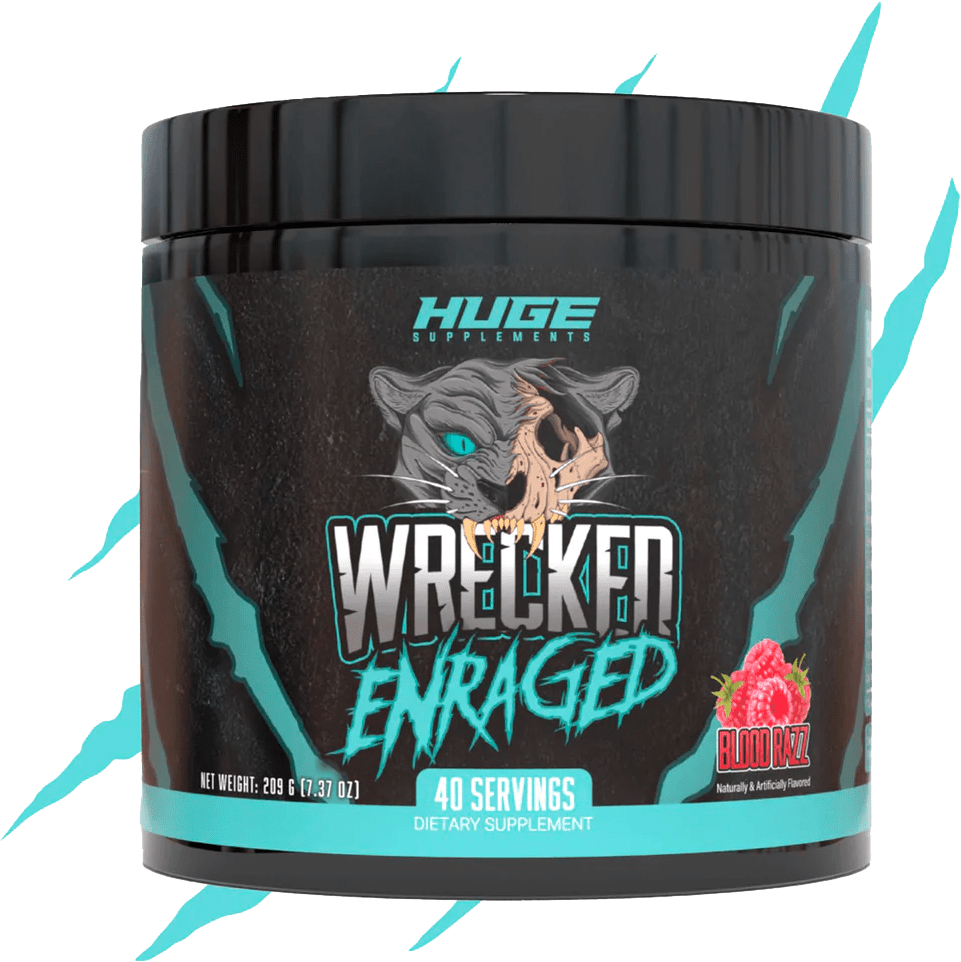Creatine Loading Phase: What It Is, How To Load, Pros & Cons
Ask a handful of athletes or fitness enthusiasts what their favorite supplements are, and you're bound to hear a few of them answer creatine. It's one of the most popular supplements thanks to its ability to improve physical performance and increase muscle mass.
Yet, it takes time to build up creatine levels within your muscles. Fortunately, you can skip the wait by undergoing a creatine loading phase. In this article, we'll dive into how loading creatine works, why it's beneficial, and how to implement it safely and efficiently into your routine to maximize results.
What Actually Is Creatine?
Think of creatine as your muscles' secret energy reserve. It's a substance made from amino acids and stored primarily in muscle cells, where it helps replenish ATP (adenosine triphosphate). ATP is the body's primary energy source for intense activities like lifting weights or sprinting.
Although creatine is found in small amounts in red meat and fish, supplementation allows you to effectively saturate muscle stores, leading to greater strength, muscle growth, and faster recovery.
It is one of the most researched and effective supplements for athletes and fitness enthusiasts. (1)
What Is A Creatine Loading Phase?
A creatine loading phase is a protocol during which you take high doses of creatine for a short period to increase your muscle stores of the compound quickly. Instead of taking a regular maintenance dose, you consume higher doses over a short period to quickly saturate your muscle cells.
This method rapidly saturates the muscles with creatine, which helps enhance performance, strength, and muscle growth more quickly than taking a standard maintenance dose right away. (2)
Once the muscles are fully saturated with creatine, a lower maintenance dose must be taken to sustain creatine levels. This helps prevent depletion and ensures that you continue to reap the performance benefits.
How To Load Creatine
The standard creatine loading phase protocol involves taking 20-25 grams of creatine daily. This dose should be split into four to five 5-gram doses spread evenly throughout the day.
This loading phase typically lasts between 5 and 7 days, greatly accelerating creatine saturation in the muscles. (3)
After these 5 to 7 days, you must continue taking creatine at a lower dose. You have to drop your dose down to 5 grams per day.
This is called the maintenance phase, and the purpose is to help maintain your cells' creatine levels, allowing you to continue your growth rate after finishing the loading stage.
The Pros Of a Creatine Loading Phase
- Faster Muscle Saturation: A creatine loading phase accelerates the saturation of muscles with creatine. Normally, it can take up to a month of taking a standard daily dose (3 to 5 grams) for muscles to reach full creatine capacity. By loading, you can achieve this in just roughly five to seven days, meaning the creatine will work a lot faster.
- Speeds Up Muscle Growth: Creatine pulls water into muscle cells, promoting cell volumization and increasing muscle size. A faster saturation period may result in quicker visible muscle fullness and mass gains.
- Strength & Power Gains: With faster saturation, you'll see improvements in strength much sooner, allowing you to lift heavier weights and perform more reps within just a few days instead of weeks.
- Rapid Benefits: Because your creatine storage is saturated quickly by the loading phase, you will notice the many benefits of creatine much faster. You will experience the improvements in physical performance in just a matter of days rather than weeks.
- Maximizes Short-Term Results: If you have a specific event or competition coming up, the loading phase ensures you reap the full benefits of creatine in a condensed timeframe, maximizing your athletic performance potential.
The Cons Of a Creatine Loading Phase
- Water Retention: Creatine increases water retention in muscles, which may lead to temporary water weight gain or a "puffy" appearance, which could be unwanted for some individuals.
- Potential Digestive Discomfort: Some individuals may experience digestive discomfort such as diarrhea due to the large doses of creatine when loading. (4) This is less common with regular, smaller doses.
- Faster Usage of Creatine: A loading phase requires higher doses (roughly 20-25 grams per day) for 5-7 days, which means you'll go through your creatine supply faster than if you were following the regular maintenance dose.
Can Creatine Loading Cause Side Effects?
Creatine loading is generally safe for most people when done correctly. (5) Research shows that creatine is well-tolerated, with no significant
adverse effects in healthy people, even at higher doses during loading.
That said, some individuals have reported stomach cramps or diarrhea, especially when taking large doses at once. That is why it is highly recommended to spread your doses throughout the day, preferably four or five doses.
Individuals with kidney issues or other underlying health conditions should consult their doctor before starting creatine, as it may put extra stress on the kidneys.
Is a Loading Phase Necessary For Creatine?
No, you don't have to load creatine - it's completely optional. A loading phase simply speeds up the process of creatine muscle saturation, but you can still get the same benefits by taking a smaller dose over time.
If you decide to do a loading phase, it takes about 5-7 days for your muscles to be fully saturated with creatine. If you don't load and go with a maintenance dose, it takes about 4 weeks on average for the muscles to get saturated.
Both methods are effective; it comes down to personal preference and goals. Just make sure that you are staying consistent with your daily creatine intake, as this is crucial for maximizing benefits.
Should I Work Out During Creatine Loading Phase?
Yes, you should work out during the creatine loading phase. If you're already training, simply continue following your workout routine to maximize the benefits of creatine.
If you haven't started working out yet, this is a great time to begin. Creatine enhances strength, endurance, and recovery, making it easier to progress in your training.
Exercise also increases blood flow to muscles, allowing creatine to be stored more efficiently.
What Happens After The Creatine Loading Phase
Once you've finished the creatine loading phase, your muscles will be fully saturated with enough creatine. This allows you to experience its full range of benefits, such as enhanced strength, improved endurance, and increased muscle mass.
However, the loading phase is just the first step. To maintain these optimal levels of creatine in the body, a daily maintenance dose is essential.
If you don't take this daily maintenance dose, your creatine storage will gradually deplete. If your storage depletes, you will notice a decrease in the benefits you've worked to achieve during loading. In other words, it could reduce strength, endurance, and muscle gains, ultimately reversing the progress made during the loading period.
Of course, you want to avoid that, so it's essential to follow a consistent creatine dosing schedule. Take 5 grams of creatine daily, and you'll be able to keep your stores at their peak and reap all the performance-enhancement benefits.
Tips For Loading Creatine
Here are some additional tips to help maximize the effectiveness and minimize any discomfort during the creatine loading phase:
Spread Your Dose Throughout The Day
Instead of consuming your entire 20-25 gram daily dose all in one go, we recommend spreading the dose throughout the day. We advise splitting the daily dose into 4 to 5 smaller doses of 4 to 5 grams, spread evenly throughout the day.
Your muscles can only absorb so much creatine at once, so by providing your body with a dose every few hours, it can more efficiently absorb and utilize the creatine, leading to faster muscle saturation.
Besides that, some people may experience digestive discomfort when taking a large amount of creatine at once. Splitting the dose also helps prevent digestive discomfort.
Make Sure You Stay Hydrated
Creatine works by pulling water into your muscles, increasing your body's demand for water. That means it's crucial to stay hydrated during the loading phase.
Aim to drink at least three, preferably four liters, of water daily to stay hydrated. This will help prevent dehydration, optimize performance, and avoid cramping. Make sure to increase your intake to prevent dehydration if you aren't drinking enough water.
Creatine Loading FAQ
Can I take my entire 20-gram dosage of creatine at once?
You can take the entire 20-gram dosage at once. However, for optimal absorption, it's better to split your doses throughout the day. We advise taking four to five smaller doses, which will be more effective and comfortable.
What happens if I miss a day of creatine during the loading phase?
It's not the end of the world if you miss a day of creatine during your loading phase. To compensate, you can extend it by an extra day and continue taking the recommended higher doses of 20 to 25 grams. Missing a day won't drastically affect your results as long as you make up for it by continuing the protocol for an extra day.
What type of creatine should I take?
We advise taking Creatine Monohydrate since it is the most studied and cost-effective option out on the market.
Conclusion
In conclusion, while a creatine loading phase isn't mandatory, it is an effective strategy if you're looking to experience the benefits of creatine as quickly as possible. By following a proper loading protocol, you can saturate your muscles with creatine within a few days, leading to faster performance improvements, muscle growth, and enhanced recovery.
However, the key to sustained results lies in consistency. After the loading phase, it's crucial to maintain your creatine levels with a daily dose of 5 grams to continue enjoying the benefits over time. As with any supplement, it's important to use creatine responsibly, stay hydrated, and listen to your body, adjusting as necessary to meet your fitness goals.
For most people, a creatine loading phase is safe and beneficial, but always consult a healthcare professional if you have any underlying conditions or concerns before starting.
References
- Buford, T. W., Kreider, R. B., Stout, J. R., Greenwood, M., Campbell, B., Spano, M., Ziegenfuss, T., Lopez, H., Landis, J., & Antonio, J. (2007). International Society of Sports Nutrition position stand: creatine supplementation and exercise. Journal of the International Society of Sports Nutrition, 4, 6. https://doi.org/10.1186/1550-2783-4-6
- Hultman, E., Söderlund, K., Timmons, J. A., Cederblad, G., & Greenhaff, P. L. (1996). Muscle creatine loading in men. Journal of applied physiology (Bethesda, Md. : 1985), 81(1), 232–237. https://doi.org/10.1152/jappl.1996.81.1.232
- van Loon, Luc & Oosterlaar, Audrey & Hartgens, Fred & Hesselink, Matthijs & Snow, Rodney & Wagenmakers, Anton. (2003). Effects of creatine loading and prolonged creatine supplementation on body composition, fuel selection, sprint and endurance performance in humans. Clinical science (London, England : 1979). 104. 153-62. 10.1042/CS20020159.
- Ostojic, S. M., & Ahmetovic, Z. (2008). Gastrointestinal distress after creatine supplementation in athletes: are side effects dose dependent?. Research in sports medicine (Print), 16(1), 15–22. https://doi.org/10.1080/15438620701693280
- Kim, H. J., Kim, C. K., Carpentier, A., & Poortmans, J. R. (2011). Studies on the safety of creatine supplementation. Amino acids, 40(5), 1409–1418. https://doi.org/10.1007/s00726-011-0878-2













Many years ago i took creatine regularly. I love it. It really does work. Then I got older and my workouts took a back seat. I went through some life changing and reaffirming experiences. As men we do that. The loss of our youth and options change us. My questions is this, —-Are there any studies with creatine on aging? I know it doesnt hurt but i just want some info to help me become motivated again to include creatine in my daily life. I have gone through 2 hip replacements on the same hip and one back surgery in the last few years. Im fighting my way back by starting a small horse ranch for first resopnders and emergency workers. Actually, no one will be excluded but i need my strength to accomplish this and my hopes are that my old friend, creatine, will help. Thank you for your help.
Leave a comment